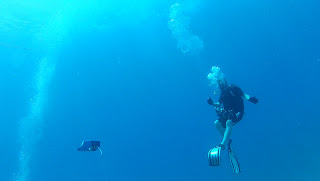What is OpenROV?
 OpenROV is a
Do It Yourself telerobotics community centered around underwater exploration and education. Company has developed a low-cost telerobotic submarine that can be built with mostly off-the-shelf parts.
The goal of OpenROV is to democratize exploration by allowing anyone to explore and study underwater environments. The
OpenROV community is also laying the foundation for globally-connected citizen scientists to share their data and findings.
OpenROV is a
Do It Yourself telerobotics community centered around underwater exploration and education. Company has developed a low-cost telerobotic submarine that can be built with mostly off-the-shelf parts.
The goal of OpenROV is to democratize exploration by allowing anyone to explore and study underwater environments. The
OpenROV community is also laying the foundation for globally-connected citizen scientists to share their data and findings.
 Powered by a small Linux computer, C-batteries, crowdsourced technology, and two guys with a thing for marine exploration, OpenROV promises to transform small remote vehicles--once the provenance of well-funded government agencies--into affordable crowdsourced machines that anyone can send on missions into the world’s oceans, lakes, and bays.
Powered by a small Linux computer, C-batteries, crowdsourced technology, and two guys with a thing for marine exploration, OpenROV promises to transform small remote vehicles--once the provenance of well-funded government agencies--into affordable crowdsourced machines that anyone can send on missions into the world’s oceans, lakes, and bays.
Designed by Eric Stackpole, and developed with David Lang, OpenROV is an open-source research and development project for the public to explore the seas (or caverns, lakes, and almost anywhere underwater where the ROV’s tether will reach). Applications range from scouting dive locations to search and rescue, as well as education.
OpenRov is being sold for $775 through its launch. Its blue body is laser cut from acrylic panels housing three thrusters (two horizontal, one vertical), an HD webcam, LED lights, and eight onboard batteries. The tiny package can dive about 300 feet (tested to 65 feet so far) and hits a top speed of about 2.2 mph during its 1.5 hour running time.
Specs: Version 2.3
Dimensions: 30cm x 20cm x 15cm
Weight: 2.5kg
Depth rating: ~100m
Speed: 1m/sec
Power: 8 onboard C batteries
Run time: ~1.5 hours
Design: Version 2.3
Body construction: Laser cut acrylic
Buoyancy: Inherently neutrally buoyant
Propulsion: 3 brushless motors (2 horizontal thrusters, 1 vertical thruster)
Tether: 1 single twisted pair communicating 10 megabit ethernet data for control and video
Control: Onboard embedded linux computer (beagleboard brand) controlled via remote web browser
Vision: Forward facing HD USB webcam and two 87lm LED light arrays on servo-tiltable platform
Design considerations: Completely open source / open hardware, off the shelf parts, small enough to test in a bathtub, kit can be assembled in one weekend, standardized payload bay.
OpenROV, a tiny battery-powered sub, is a bringing ocean exploration into your home.Your personal remote operated submersible is ready.
 OpenROV is a
Do It Yourself telerobotics community centered around underwater exploration and education. Company has developed a low-cost telerobotic submarine that can be built with mostly off-the-shelf parts.
The goal of OpenROV is to democratize exploration by allowing anyone to explore and study underwater environments. The
OpenROV community is also laying the foundation for globally-connected citizen scientists to share their data and findings.
OpenROV is a
Do It Yourself telerobotics community centered around underwater exploration and education. Company has developed a low-cost telerobotic submarine that can be built with mostly off-the-shelf parts.
The goal of OpenROV is to democratize exploration by allowing anyone to explore and study underwater environments. The
OpenROV community is also laying the foundation for globally-connected citizen scientists to share their data and findings.
 Powered by a small Linux computer, C-batteries, crowdsourced technology, and two guys with a thing for marine exploration, OpenROV promises to transform small remote vehicles--once the provenance of well-funded government agencies--into affordable crowdsourced machines that anyone can send on missions into the world’s oceans, lakes, and bays.
Powered by a small Linux computer, C-batteries, crowdsourced technology, and two guys with a thing for marine exploration, OpenROV promises to transform small remote vehicles--once the provenance of well-funded government agencies--into affordable crowdsourced machines that anyone can send on missions into the world’s oceans, lakes, and bays.Designed by Eric Stackpole, and developed with David Lang, OpenROV is an open-source research and development project for the public to explore the seas (or caverns, lakes, and almost anywhere underwater where the ROV’s tether will reach). Applications range from scouting dive locations to search and rescue, as well as education.
OpenRov is being sold for $775 through its launch. Its blue body is laser cut from acrylic panels housing three thrusters (two horizontal, one vertical), an HD webcam, LED lights, and eight onboard batteries. The tiny package can dive about 300 feet (tested to 65 feet so far) and hits a top speed of about 2.2 mph during its 1.5 hour running time.
Specs: Version 2.3
Dimensions: 30cm x 20cm x 15cm
Weight: 2.5kg
Depth rating: ~100m
Speed: 1m/sec
Power: 8 onboard C batteries
Run time: ~1.5 hours
Design: Version 2.3
Body construction: Laser cut acrylic
Buoyancy: Inherently neutrally buoyant
Propulsion: 3 brushless motors (2 horizontal thrusters, 1 vertical thruster)
Tether: 1 single twisted pair communicating 10 megabit ethernet data for control and video
Control: Onboard embedded linux computer (beagleboard brand) controlled via remote web browser
Vision: Forward facing HD USB webcam and two 87lm LED light arrays on servo-tiltable platform
Design considerations: Completely open source / open hardware, off the shelf parts, small enough to test in a bathtub, kit can be assembled in one weekend, standardized payload bay.




0 comments